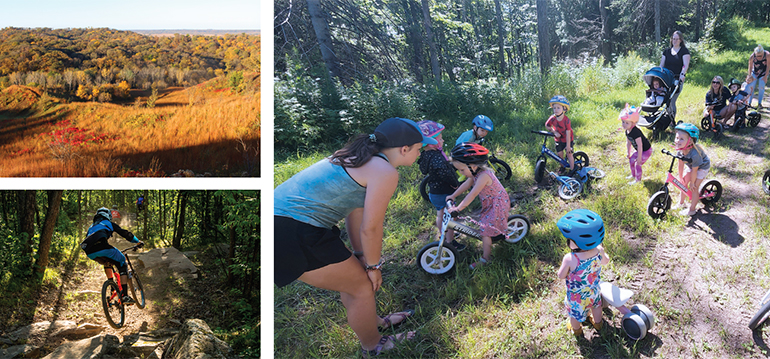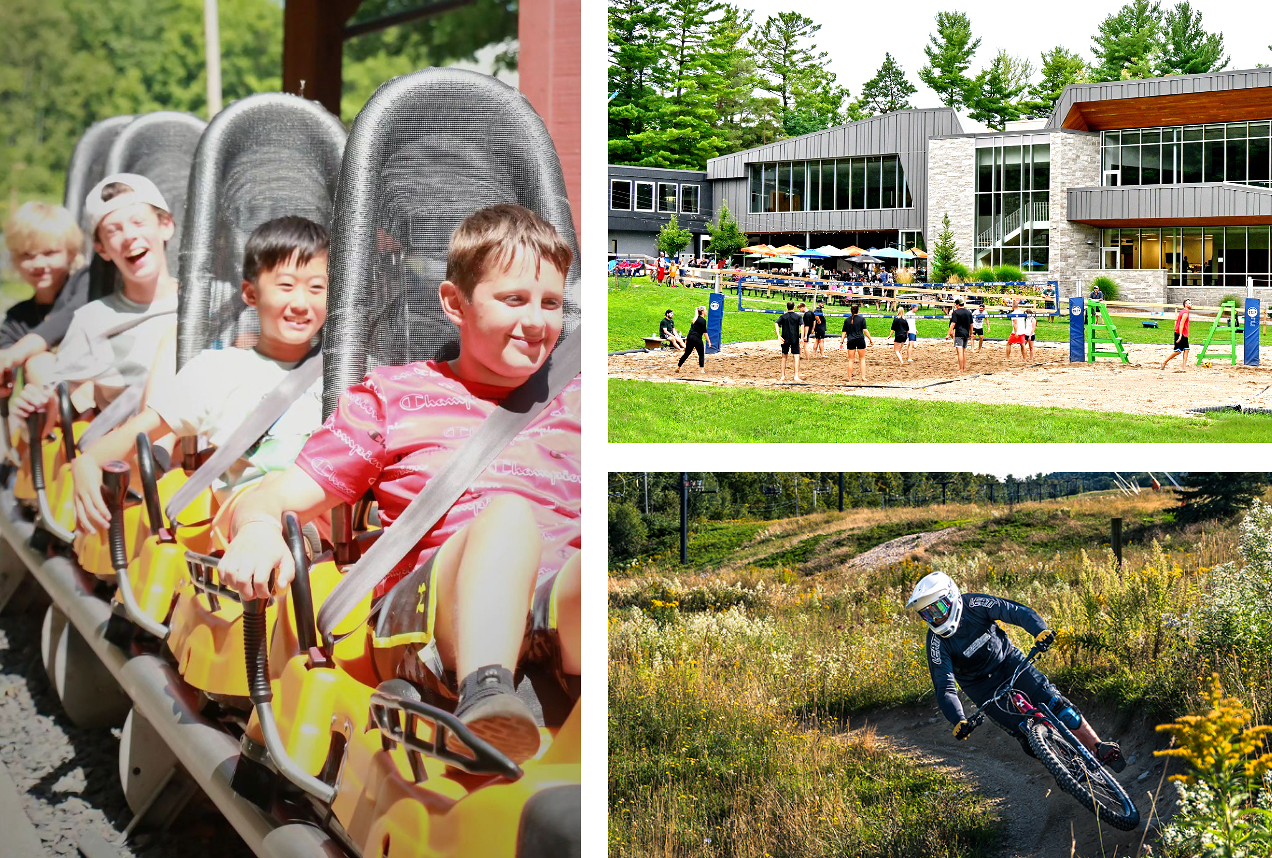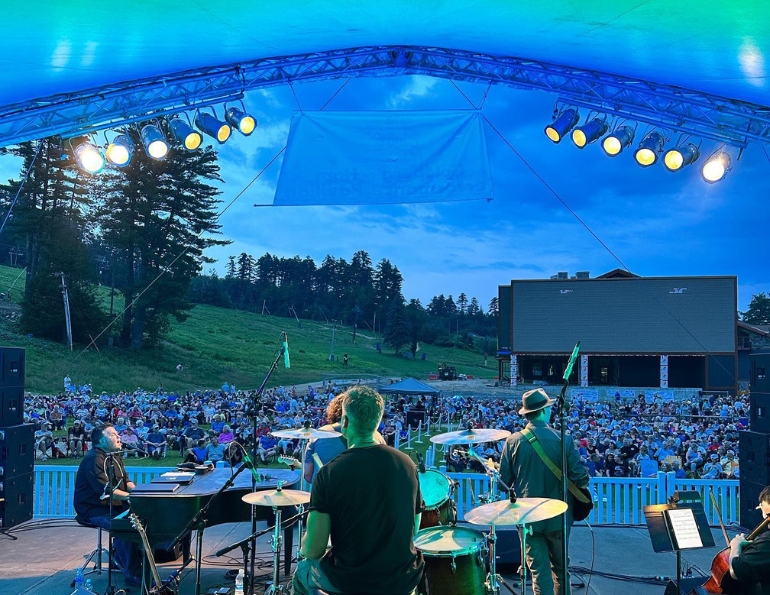What defines success for a resort’s summer operations? Claire Humber of SE Group posed this question to a few areas ahead of SAM’s Summer Ops Camp in September, where a session she led examined the topic further. It turns out that just as summer activities, programs, and events vary between operations, so do the goals and metrics that measure success.
“It’s been an interesting journey to track how the industry has evolved (in defining operational success), and how the conversations have evolved,” says Humber. “No one has the same ski area, the same brand, or the same natural environment, so no one is going to have the same offerings. Not everyone is going to measure success in the same way.”
And though “profit” might be the immediate answer, “success,” Humber discovered, is much more nuanced. “We are in a business, we know that,” she says. “But we kept the dialogue going, and it really added this wonderful complexity to the conversation.”
Success is: Humans and Nature in Symbiosis
To define success at Mt. Crescent Ski Area, a community-owned operation in Pottawattamie County, Iowa, context is critical, says Jeff Franco, county conservation deputy director.
Iowa is now considered the most physically altered state in the country, says Franco, with less than one-tenth of one percent of its original prairie remaining, nearly all lost to agricultural tilling. At the same time, its western region, home to Mt. Crescent, just happens to home a natural phenomenon called the Loess Hills landform. Only two such landforms exist in the world, the other in China.
“Most of Iowa’s remnant prairie exists in the Loess Hills, with many of the Loess Hills’ largest tracts existing at Hitchcock Nature Center and Mt. Crescent,” says Franco.
 Iowa’s Mt. Crescent is home to a rare natural phenomenon, the Loess Hills landform.
Iowa’s Mt. Crescent is home to a rare natural phenomenon, the Loess Hills landform.
Conservation meets recreation. Mt. Crescent, founded by Stein Ericksen in 1961, was purchased in 2021 by the Pottawattamie County Conservation Department. The intent wasn’t to stop the skiing, but to add it to its neighboring Hitchcock Nature Center with hopes of developing a symbiotic relationship between the educational and recreational components of the two. The idea was that it could continue to not just preserve the land, but also to celebrate it and share it with residents and visitors.
“The hope is that by experiencing the land, and witnessing our example of what a healthy human-natural environment relationship looks like, our visitors grow a greater respect and appreciation for it, and ideally, greater support for its care,” says Franco.
“Success is achieved when the human and the natural environments flourish through actions that promote the well-being of both,” he adds. “We further succeed when, by our actions and words, we challenge and change our visitors’ notions of what it means to have a healthy relationship with the natural world. And, if in the process, we can manage to give a few dollars back to the people, all the better.”
Success is: Meeting the Mission
Spirit Mountain Recreation Area is a public entity created by the Minnesota Legislature with the aim to generate multiple outdoor recreation opportunities for residents and visitors and to aid the economy of northeastern Minnesota. “That’s our mission. Every activity we support, including pay-to-play and free opportunities, helps us realize it,” says interim director Ann Glumac.
Owned and operated by the city of Duluth, Spirit Mountain’s summer offerings include an alpine coaster, zip line, and downhill bike park, as well as a mountain bike camp for kids, among other activities. Roughly a third of its annual gross revenue comes from summer operations.
Numerous metrics. “Spirit is both a tourist attraction and a community resource that enhances the quality of life for residents in the city,” says Glumac. “Its campus supports hikers, sightseers, birdwatchers, snowmobilers, rock climbers, and others who do not pay a fee. Given these factors, defining success for our summer ops requires a diversity of metrics.” These include profitability, ROI, and fostering future users as well as more esoteric measures, like “the cool factor,” says Glumac.
“Most of our summer ops—the Adventure Park, campground, banquets—are expected to generate significant operating profit to help us through the fall shoulder season and winter preparations and contribute to our overall operating profit,” says Glumac. “In this instance, we define success as generating additional operating profit.”
Glumac says other amenities, like disc golf, lose money but fulfill Spirit’s mission to provide multiple recreational opportunities. “In this instance, success is defined as being closer to breaking even than not and attracting a new user group.”
As for fostering participants, success is when kids going through the bike camp buy a season pass. And the “cool factor”? Duluth was named “Best Town Ever” by Outside. “As such, we have the opportunity to enhance our ‘cool factor’ with summer programming, making Spirit a desirable resort for both guests and employees. Metrics in this case are, again, longer term—ideally, we will see summer guests who perceive Spirit as a summer hub for outdoor recreation in Duluth.”
All of this means that Spirit is fulfilling its mission. “Teasing out the rationale for why visitors choose to vacation in Duluth is beyond our ability,” says Glumac. “However, a visit to the Adventure Park on a busy summer weekend indicates our guests are far more diverse and seen in a greater percentage than found in the Duluth population, which is an indication of tourism. We consider that a subjective metric of demonstrated success.”
Success is: Playing the Long Game
At Killington, Vt., summer business success has relied on growing operations methodically, especially with building out its bike park, says president and GM Mike Solimano.
“We went slow and proved we could grow visits rather than building the big plan and hoping we’d be successful right from the beginning,” says Solimano. “From the beginning we were cash positive, even if we didn’t cover all the capital.”
As operations grow, it’s important to look at the bigger picture and think about the revenue and expense of any attraction to really define and follow your next steps, notes Solimano.
Slow going is easier said than done, Humber points out. “When you start doing something new, you get excited about the visits and the revenue and you might not take a step back and say, ‘OK, what about the expense side of the equation? What about the incremental burden cost?’”
 Clockwise, starting upper left: Mt. Crescent, purchased in 2021 by the Pottawattamie County Conservation Department to add to its neighboring Hitchcock Nature Center, offers both education and recreation; Kids’ bike camps are part of the summer profit model at Minnesota’s Spirit Mountain and help it to meet its community-minded mission; If summer camps lead to more mountain bike passes sold at Spirit, it’s a win-win.
Clockwise, starting upper left: Mt. Crescent, purchased in 2021 by the Pottawattamie County Conservation Department to add to its neighboring Hitchcock Nature Center, offers both education and recreation; Kids’ bike camps are part of the summer profit model at Minnesota’s Spirit Mountain and help it to meet its community-minded mission; If summer camps lead to more mountain bike passes sold at Spirit, it’s a win-win.
Success is: Unique Guest Experiences
At Alterra-owned Steamboat, which is nearing completion of a multi-year, $200 million capital improvement, creating unique experiences remains the most evident metric of success.
“Guests want something unique,” says Dave Hunter, VP of resort operations. “We are in the experience business, and it’s a very competitive field, so what are you offering that is unique and different and attractive to the people that are going to come to your area?”
All encompassing. Providing such “experiences” speaks to every aspect of an operation, says Hunter. Supporting lodging means giving overnight guests things to do. Retaining year-round staff means staying competitive in a tight job market. And it all lends to maintaining visitation levels year-round, increasing year-round brand awareness, and increasing length of stay and average spend.
For Steamboat, this means being exceedingly clear on its brand and on its market. “Steamboat is starting to be very methodical around what that’s going to be for summer,” says Humber. “As it expands the scope and offerings, it’s broadening its audience and lengthening that seasonality, as well as streamlining operations. To do that in a way that is true to your brand and to the rest of your operations is key.”
 Clockwise, starting upper left: Spirit Mountain relies on its adventure park and activities like a mountain coaster to provide operating profit for the shoulder season and pre-winter prep; Ontario’s Boler Mountain hosts summer events like volleyball tournaments and offers mountainside dining throughout the summer to keep F&B staff employed year-round; Killington’s bike park success is due in part to a slow, methodical approach to growth.
Clockwise, starting upper left: Spirit Mountain relies on its adventure park and activities like a mountain coaster to provide operating profit for the shoulder season and pre-winter prep; Ontario’s Boler Mountain hosts summer events like volleyball tournaments and offers mountainside dining throughout the summer to keep F&B staff employed year-round; Killington’s bike park success is due in part to a slow, methodical approach to growth.
Success is: Retaining Staff
After much analysis, management at Ontario’s Boler Mountain decided to make a capital investment in the unknown: summer ops. In 2013, the resort added a treetop challenge course, which guests loved. But there was a conundrum: would there be enough staff to work it?
“We were unsure of the labor commitment from key staff, as we felt they may have already been tapped out,” says Boler manager Marty Thody.
Instead, staffers were excited to come to work, and they were busy. In turn, Boler added more to its summer line-up—a trail system for mountain biking, a weekly bike race series, even a volleyball tournament. Eventually, the resort entered the wedding and corporate retreat game—a cause for soul-searching, albeit with an upside, says Thody.
“I still struggle with this [event programming], because it doesn’t really fit with the outdoor adventure brand we have developed,” he says. “But what it does is keep our very talented kitchen staff working at what they do best. Just a word of advice: kitchen people are horrible at most other jobs you may offer them to keep them year-round. So, giving them a canvas to paint on goes a long way to keeping them, and talented kitchen staff are hard to find.”
Humber notes that F&B staffing has become a more prevalent issue in the industry. “Almost everyone that I spoke to said something similar—whether it was just the general idea of getting and keeping staff, or the subset of people that specifically spoke about food and beverage staffing, which is a component of our operations that’s gotten louder and prouder over the last decade or so.”
Boler now has a patio restaurant that’s open four days a week. It barely breaks even, says Thody, but it’s worth it to fill the 40-hour commitment to the F&B staff and offers summer patrons a place to hang out.
The venture has proved quite successful overall. “We now have a vibrant summer business that contributes about 30 percent of total revenue,” says Thody.
And the best thing? Key staff sticks around.
Keeping managers. At New Hampshire’s Cranmore, which attracts anywhere from 300-500 visitors per day in the summer, retaining year-round management and staff is likewise considered a top indicator of success, says president and general manager Ben Wilcox. Before the resort beefed up its summer operations, Wilcox says it had 15 full-time year-round employees who mostly focused on summer maintenance. “It was very common for us to have to look for six to eight new seasonal managers for the upcoming winter.”
Now, says Wilcox, Cranmore need only find “one to two managers each year,” while it retains 45 year-round managers and core staff. “Our overall turnover rate has dropped way off,” he says, “and year-round food and beverage operations allow us to keep a consistent staff.”
Making a year-round commitment to managers and staff, says Wilcox, “keeps them engaged with your resort and provides them with the benefits they need to stay with you.”
 Left to right: At CLIMB Works, zip lines remain the core business, but complementary offerings add overall value, as long as they can also stand alone; Arts Jubilee, a six-week concert series, helps keep Cranmore, N.H., in action year-round.
Left to right: At CLIMB Works, zip lines remain the core business, but complementary offerings add overall value, as long as they can also stand alone; Arts Jubilee, a six-week concert series, helps keep Cranmore, N.H., in action year-round.
Success is: Hitting Business Goals
Return on investment. Cranmore has also gauged success of specific summer attractions through a hard look at ROI. “When studying which to add, we did a thorough ROI evaluation,” says Wilcox. “Most, if not all, of our attractions see a 3-to-5-year ROI, therefore you move into the black after a few seasons. But it’s important to ask: ‘Is this a trendy attraction that won’t last?’ Or ‘is this a high-priced attraction that will require a long-term payoff?’ Both scenarios may be worth it depending on your goals.”
There’s also a focus on “keeping your resort alive year-round,” which Cranmore answers by hosting events like the Arts Jubilee, a six-week concert series, and investing in real estate—it’s in the process of adding 100 new base-area condos, for which sales depend on maintaining a vibrant year-round resort.
Back to basics. At Massanutten, Va., it’s simple. “I’d define success as meeting or exceeding stated goals (budget),” says general manager Kenny Hess. “That means providing amenities that make guests come back and that make them want to spend their money here. If we can do those things, we’ll be successful in reaching our goals.”
To reach its goals, Massanutten offers a range of activities and experiences—more than 100 in all—across the resort’s 6,000 total acres, which appeal to overnight guests and homeowners who stay at the numerous condo units and hotels that dot the property. The resort has intentionally created an atmosphere to attract and retain visitors.
“In a non-monetary sense,” Hess adds, “success is seeing a smiling guest and hearing them say ‘I want to do that again.’”
Success is: An Honest Review
“Since everyone tried to produce venues that would attract summer guests, the market and the usefulness of those venues has changed,” notes Tom Day, GM at Gunstock, N.H. “So, three years ago, we reviewed all the offerings we had. Did they serve a purpose? And more importantly, did they make money?”
After an honest review that examined all the expenses and usage data, a few attractions were eliminated.
Less is more. “That process really opened our eyes to our existing operations,” adds Day. The resort had settled into a “long-time operating schedule” without reviewing it periodically for efficiency, he says. Its zip line, aerial treetop adventure course (ATA), mountain coaster, and scenic lift ride were operating seven days a week, but that wasn’t cost effective.
“So, we changed our schedule to four days a week and now require reservations on the zip and ATA,” says Day. “This enabled us to drive demand and fill up those venues most of the time, while eliminating a lot of labor and management expenses.”
This speaks to the evolution of summer ops, notes Humber. “It started out with ‘Let’s have some things to do,’ and then it was, ‘oh, but if we had more things to do, we could keep people here longer.’ That’s not always the answer and may detract from achieving success.”
“Every piece of your operation has to be accountable in some way for success,” says Day. “That may be different [for different activities], but each must be accountable in some way.”
CLIMB Works operates two world-class zip line destinations and its owner, Nick Thompson, has seen lots of summer resort operations up close. Thompson says that many years of focusing on complementary businesses vs. core business have redefined success, at least for him.
“We have many businesses that will never bring in the same amount of profit as our main core business, but we have justified their existence because of the seemingly complementary, intangible value,” says Thompson. “Internally, our redefined definition of success is that it is only complementary if it can stand on its own two feet, otherwise it’s a drain of our most important and limited resources—people and time.”






